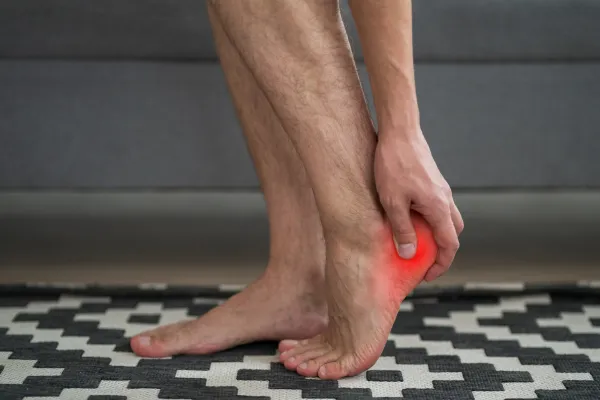Tips & Advice From Foot & Ankle Associates of Southern NH

Heel Spurs: What They Are, How They Form, and Treatment Options
Heel spurs are a common cause of heel pain that can be extremely uncomfortable, especially when walking or standing for long periods. At Foot and Ankle Associates of Southern NH, we want to help you understand what heel spurs are, how they develop, and the treatment options available to relieve pain and restore mobility.
What is a Heel Spur?
A heel spur is a bony growth that forms on the underside of the heel bone (calcaneus). It typically develops where the plantar fascia (the thick band of tissue running across the bottom of the foot) attaches to the heel bone. Heel spurs are often associated with plantar fasciitis, a condition where the plantar fascia becomes inflamed.
Although heel spurs are visible on X-rays, not everyone with a heel spur experiences pain. In fact, many people have heel spurs without knowing it. However, when a spur causes irritation or damage to the surrounding tissues, it can lead to significant discomfort.
How Heel Spurs Form
Heel spurs form over time due to prolonged pressure on the foot, particularly the heel. The process typically starts with inflammation in the plantar fascia, often as a result of repetitive stress or overuse. This inflammation leads to small tears in the tissue, and as the body tries to repair these tears, calcium deposits accumulate at the site of the injury. Over time, these deposits build up, forming a bony protrusion—the heel spur.
Factors that contribute to the development of heel spurs include:
Excessive Foot Stress: Repeated activities such as running, walking, or standing for long periods can put added pressure on the heel and plantar fascia, leading to the formation of a heel spur.
Improper Footwear: Shoes that lack proper arch support, cushioning, or a proper fit can increase stress on the heel and lead to heel spur development.
Obesity: Carrying excess weight puts additional pressure on the feet, particularly the heel, contributing to the formation of heel spurs.
Foot Mechanics: Conditions like flat feet or high arches can alter your gait and place uneven stress on your feet, making heel spurs more likely.
Symptoms of Heel Spurs
In many cases, heel spurs cause no symptoms at all. However, when they do cause discomfort, the most common symptoms include:
Sharp Heel Pain: Pain is usually felt at the bottom of the heel, especially when you first get out of bed in the morning or after long periods of rest. This pain may decrease as you walk around but can return after standing for extended periods.
Swelling and Tenderness: The area around the spur may become swollen and tender to the touch, particularly if the spur is pressing on surrounding tissues.
Pain that Increases with Activity: People with heel spurs often report that the pain worsens with physical activity, especially high-impact activities like running or jumping.
Treatment Options for Heel Spurs
Fortunately, there are a variety of treatment options available to alleviate the pain associated with heel spurs and improve mobility. Treatment methods range from conservative measures to more advanced therapies.
Rest and Ice: Resting the foot and applying ice to the affected area can help reduce inflammation and relieve pain.
Proper Footwear: Wearing shoes with adequate arch support and cushioning is essential in relieving pressure on the heel. Avoid shoes with thin soles or high heels that can exacerbate the problem.
Custom Orthotics: Custom orthotics are insoles designed to fit your foot’s unique shape and provide extra cushioning and support. They can help correct abnormal gait patterns that contribute to heel pain.
Stretching and Physical Therapy: Stretching exercises for the plantar fascia, Achilles tendon, and calf muscles can help relieve tension and reduce pain. Physical therapy may also be recommended to strengthen the foot and improve flexibility.
Nonsteroidal Anti-inflammatory Drugs (NSAIDs): Over-the-counter medications like ibuprofen can help reduce inflammation and alleviate pain in the short term.
Corticosteroid Injections: In cases where pain persists, a podiatrist may recommend a corticosteroid injection to reduce inflammation and provide temporary relief.
Shockwave Therapy: Extracorporeal shock wave therapy (ESWT) uses high-energy sound waves to stimulate healing in the damaged tissue, offering relief from chronic heel pain caused by heel spurs.
Surgery: Surgery is typically reserved for severe cases that don’t respond to conservative treatments. The procedure involves removing the heel spur and repairing any associated tissue damage.
Preventing Heel Spurs
To prevent heel spurs from developing, it’s important to take steps that minimize stress on your feet. Some preventive measures include:
Wearing shoes with proper arch support and cushioning
Avoiding high-impact activities if you're prone to heel pain
Maintaining a healthy weight to reduce pressure on the feet
Regularly stretching your feet, calves, and Achilles tendon to prevent tightness
Conclusion
Heel spurs may seem like a minor issue, but they can cause significant pain and discomfort, particularly if left untreated. Understanding the causes of heel spurs and taking steps to treat and prevent them can help you maintain healthy, pain-free feet. If you’re experiencing heel pain, don't hesitate to reach out to Foot and Ankle Associates of Southern NH. Our team of experts is here to help you find the best solution for your foot health and get you back on your feet.
Ask Foot & Ankle Associates of Southern NH And Their Team
Fill in the form to request a call from our team. One of our team members will call you for FREE and answer any questions or concerns you may have about your condition
Where To Find Foot & Ankle Associates of Southern NH

If you have any questions before scheduling an appointment or for general inquiries, please use the contact us button below. Our team will promptly reach out to assist you.
Opening Hours
Monday: 8:00am – 5:00pm
Tuesday: 8:00am – 5:00pm
Wednesday: 8:00am – 2:00pm
Thursday: 8:00am – 5:00pm
Friday: 8:00am – 2:00pm
Saturday: Closed
Sunday: Closed

